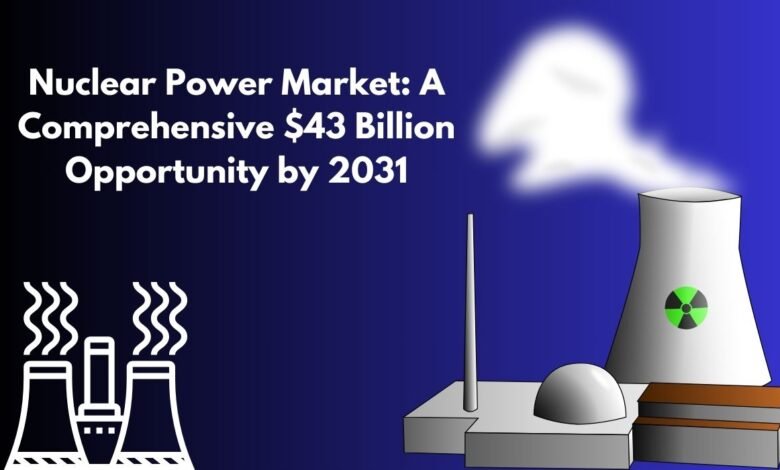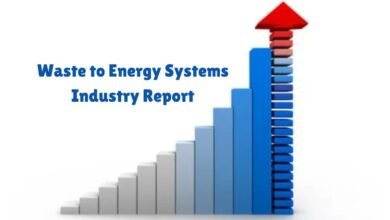Nuclear Power Market: A Comprehensive $43 Billion Opportunity by 2031
Is Nuclear Power Back? Market Analysis Reveals Surprising Growth Potential

Is nuclear power a rising star? Dive into the nuclear power market analysis & discover its projected growth of $43 billion by 2031.
The nuclear power market holds a pivotal role in the global energy landscape, providing a significant contribution to the world’s electricity supply. With its origins tracing back to the mid-20th century, nuclear energy has evolved to become a cornerstone in the quest for reliable and low-carbon energy sources. The importance of nuclear power cannot be overstated, especially as countries worldwide grapple with the dual challenges of climate change and energy security.
Historically, the development of nuclear power was driven by the need for a powerful and efficient energy source. The first commercial nuclear power plants began operations in the 1950s, marking the start of a new era in energy production. Over the decades, advancements in technology have enhanced the safety, efficiency, and economic viability of nuclear plants, making them a critical component of the energy mix in many nations.
Today’s nuclear power market is characterized by its potential to produce large quantities of electricity with minimal greenhouse gas emissions. This attribute positions nuclear energy as a key player in efforts to mitigate climate change. Unlike fossil fuels, nuclear reactors do not emit carbon dioxide during operation, making them an attractive option for countries aiming to reduce their carbon footprint while ensuring a stable energy supply.
Several factors drive the growth of the nuclear power market. These include the increasing global demand for electricity, the need to diversify energy sources, and the imperative to meet international climate targets. Additionally, advancements in reactor technology, such as small modular reactors (SMRs), promise to make nuclear power more accessible and adaptable to different energy needs.
Currently, the market faces a complex landscape. While some regions witness a resurgence in nuclear energy investment, others contend with public apprehension and regulatory hurdles. Nonetheless, the strategic importance of nuclear power in achieving a sustainable and secure energy future remains undisputed.
As project into the future, the nuclear power market’s trajectory will be shaped by technological innovations, policy decisions, and global efforts to combat climate change. This comprehensive research study aims to explore these dynamics, providing insights into the market’s size, share, and potential developments from 2024 to 2031.
Market Size and Growth Projections
The nuclear power market is poised for substantial growth between 2024 and 2031. According to credible sources, the market is expected to expand at a compound annual growth rate (CAGR) of approximately 4.5%. By 2031, the market valuation is projected to exceed USD 120 billion, driven by increasing capacity additions and advancements in nuclear technology. This growth trajectory underscores the significant role nuclear energy is set to play in the global energy mix.
One of the primary drivers of this expansion is the ongoing development and deployment of advanced nuclear reactors, including small modular reactors (SMRs) and Generation IV reactors. These technological advancements offer enhanced safety features, improved efficiency, and reduced environmental impact, making nuclear power a more attractive option for both developed and developing nations. As a result, significant investments are being funneled into research and development to bring these next-generation reactors to commercial viability.
Government policies and international agreements also play a pivotal role in shaping the growth of the nuclear power market. For instance, the Paris Agreement has galvanized efforts to reduce carbon emissions, prompting many countries to revisit their energy strategies and consider nuclear power as a viable solution for achieving their climate goals. Additionally, supportive regulatory frameworks and financial incentives are being introduced to facilitate the construction of new nuclear plants and the modernization of existing ones.
Another contributing factor to the market’s growth is the rising demand for reliable and stable energy sources. As global energy consumption continues to rise, especially in emerging economies, nuclear power is increasingly seen as a dependable alternative to intermittent renewable sources like wind and solar. This reliability is crucial for meeting base-load power requirements and ensuring energy security.
Furthermore, trends in capacity additions highlight a renewed interest in nuclear energy. Several countries, including China, India, and Russia, are leading the charge with ambitious plans to expand their nuclear power capabilities. These nations are not only investing in new nuclear plants but are also upgrading their existing infrastructure to enhance efficiency and safety.
Overall, the nuclear power market is set to experience robust growth over the forecast period, driven by technological innovation, supportive government policies, and the pressing need for sustainable and reliable energy solutions.
Key Market Segments
The nuclear power market is characterized by various key segments, each offering unique growth opportunities and challenges. These segments include reactor types, applications, and geographic regions. Understanding these segments is crucial for comprehending the overall dynamics of the nuclear power market from 2024 to 2031.
Reactor Types: The market is predominantly segmented by reactor types such as Pressurized Water Reactors (PWR), Boiling Water Reactors (BWR), and Small Modular Reactors (SMR). PWRs hold the largest market share due to their widespread use and established technology. BWRs, while less prevalent than PWRs, continue to be a significant segment due to their efficiency in power generation. SMRs are gaining traction owing to their flexibility, enhanced safety features, and suitability for smaller grid systems, predicting a robust growth trajectory in the coming years.
Applications: Nuclear power is utilized in various applications, primarily power generation, but also in medical and industrial sectors. The power generation segment dominates the market, driven by the global demand for clean and reliable energy. Medical applications, including cancer treatment and diagnostic imaging, are experiencing growth due to advancements in nuclear medicine. Industrial applications, such as in material testing and food irradiation, are also expanding, contributing to the market’s diversity.
Geographic Regions: The nuclear power market is segmented geographically into North America, Europe, Asia-Pacific, and the Rest of the World. North America and Europe have mature markets with significant nuclear infrastructures. However, Asia-Pacific is the fastest-growing region, propelled by rapid industrialization and increasing energy demands in countries such as China and India. The Rest of the World segment, including regions like the Middle East and Africa, is also showing potential due to emerging nuclear energy projects and government support.
Each segment within the nuclear power market presents distinct opportunities and challenges. Companies operating in this space need to navigate these segments strategically to leverage growth potential and address emerging trends effectively.
Major Players in the Nuclear Power Industry
The nuclear power industry is characterized by several key players who significantly influence the market’s trajectory. These entities, ranging from multinational corporations to specialized organizations, play a crucial role in the development, deployment, and advancement of nuclear technologies.
Among the industry’s titans, Electricité de France (EDF) stands out. EDF is a global leader in nuclear energy with an extensive portfolio of nuclear reactors. The company has implemented a robust market strategy focusing on sustainability and innovation. Recent financial performance has been steady, bolstered by strategic partnerships aimed at enhancing reactor efficiency and safety. Noteworthy developments include EDF’s involvement in next-generation nuclear projects, such as the European Pressurized Reactor (EPR).
Westinghouse Electric Company is another significant player. Renowned for pioneering the pressurized water reactor technology, Westinghouse has been at the forefront of nuclear energy innovation. The company’s market strategy heavily emphasizes research and development, particularly in small modular reactors (SMRs). Financial reports indicate a consistent growth trajectory, supported by a series of mergers and acquisitions that have expanded its technological capabilities and market reach. Recent collaborations with international entities underscore its commitment to global nuclear energy solutions.
In the Asian market, China National Nuclear Corporation (CNNC) is a dominant force. CNNC’s strategy revolves around expanding its nuclear fleet and exporting nuclear technology. The corporation’s financial performance reflects strong government backing and substantial investments in nuclear infrastructure. Recent developments include significant progress in the Hualong One reactor technology, positioning CNNC as a key player in the global nuclear power landscape.
Additionally, Rosatom, Russia’s state nuclear energy corporation, plays a pivotal role in the industry. Rosatom’s integrated approach encompasses the entire nuclear supply chain, from uranium mining to reactor construction and decommissioning. The company’s market strategy is characterized by aggressive international expansion and technology exports. Financially, Rosatom has demonstrated resilience and growth, driven by strategic agreements and long-term contracts with various countries.
Partnerships, mergers, and acquisitions are central to shaping the nuclear power market. For instance, the collaboration between EDF and General Electric to improve nuclear turbine technology exemplifies the synergies being formed to advance nuclear power. Similarly, the acquisition of nuclear assets by Westinghouse has fortified its market position, while CNNC’s joint ventures have facilitated technological exchange and market penetration.
Major players in the nuclear power industry are actively shaping the market through strategic initiatives, financial robustness, and technological advancements. Their efforts are pivotal in driving the future of nuclear energy, ensuring its role in the global energy mix remains significant and sustainable.
Technological Innovations and Advancements
The nuclear power market is on the cusp of significant transformation, driven by continuous technological innovations and advancements. One of the critical areas witnessing rapid development is reactor design. Modern reactors are being engineered to be more efficient, safer, and environmentally friendly compared to their predecessors. Advanced reactor designs like Generation IV reactors promise enhanced safety features, better fuel efficiency, and reduced waste production. These reactors are expected to play a pivotal role in the future energy landscape.
In addition to reactor design, safety features have seen remarkable advancements. Modern nuclear reactors incorporate passive safety systems that function without human intervention or external power sources, significantly mitigating the risk of accidents. Innovations such as advanced containment structures and improved core cooling mechanisms are setting new benchmarks in reactor safety, addressing public concerns and regulatory demands.
Fuel technology has also evolved substantially. The development of accident-tolerant fuels (ATFs) is a game changer for the industry. These fuels are designed to withstand higher temperatures and resist damage under accident conditions, thereby enhancing the overall safety of nuclear power plants. Furthermore, advancements in fuel recycling and reprocessing technologies are contributing to sustainability by reducing nuclear waste and making better use of available resources.
Emerging technologies such as small modular reactors (SMRs) are poised to revolutionize the nuclear power market. SMRs offer several advantages, including lower initial capital investment, enhanced safety features, and the ability to be deployed in remote locations or smaller grids. Their modular nature allows for scalable power generation, making them an attractive option for a diverse range of applications. As these technologies mature, they are expected to significantly impact the market dynamics, providing flexible and economical solutions to meet the growing energy demand.
Overall, technological innovations and advancements in reactor design, safety features, fuel technology, and emerging technologies like SMRs are shaping the future of the nuclear power market. These developments are not only enhancing efficiency and safety but also paving the way for a more sustainable and resilient energy system.
Regulatory Environment and Policy Framework
The regulatory landscape governing nuclear power is multifaceted, involving both international and national regulations aimed at ensuring safety, environmental protection, and sustainable development. International organizations like the International Atomic Energy Agency (IAEA) set global safety standards and guidelines that member countries are encouraged to adopt. These standards cover various aspects of nuclear power, including reactor safety, radioactive waste management, and emergency preparedness.
On a national level, individual countries have their own regulatory bodies that oversee nuclear power activities. For example, the United States has the Nuclear Regulatory Commission (NRC), while the United Kingdom’s Office for Nuclear Regulation (ONR) plays a similar role. These agencies are responsible for licensing, inspections, and enforcement of safety measures. They also work closely with other governmental entities to ensure compliance with environmental laws and policies.
Recent policy changes have significantly influenced the nuclear power market. For instance, the European Union’s Green Deal and the United States’ Clean Energy Standards have both emphasized the need for low-carbon energy sources, including nuclear power. These initiatives aim to reduce greenhouse gas emissions and combat climate change, thereby providing a favorable environment for the growth of nuclear energy. Additionally, some countries have revised their policies to extend the operational life of existing nuclear plants, further sustaining market demand.
Safety remains a paramount concern, and new regulations often focus on enhancing safety measures. For instance, post-Fukushima, many countries have introduced stricter safety protocols and upgraded existing reactors to meet higher safety standards. These regulatory updates often involve significant investments in technology and infrastructure, but they are essential for gaining public trust and ensuring long-term sustainability.
The evolving policy framework and regulatory environment will continue to shape the future of the nuclear power market. Understanding these dynamics is crucial for stakeholders looking to navigate the complexities of this highly regulated sector. The interplay between policy changes, safety standards, and market growth will be key determinants in the development of nuclear power from 2024 to 2031.
As the nuclear power market progresses towards 2031, it faces a series of significant challenges that could impact its growth and development. One of the foremost issues is public perception. Despite the technological advancements and safety measures implemented in recent years, nuclear power continues to struggle with a negative image. Incidents like the Fukushima disaster have left an indelible mark on public consciousness, leading to widespread skepticism and resistance to new projects. Overcoming this challenge requires not only technological advancements but also transparent communication and public engagement strategies to rebuild trust.
Another critical challenge is waste management. The disposal of radioactive waste remains a contentious issue, with long-term storage solutions still under development. Effective waste management strategies are essential to ensure the sustainability and safety of nuclear power operations. Innovations in this area, such as advanced recycling technologies and deep geological repositories, are crucial to address these concerns and demonstrate the viability of nuclear power as a long-term energy solution.
High capital costs also pose a significant barrier to the expansion of nuclear power. The initial investment required for constructing nuclear power plants is substantial, often making it less attractive compared to other energy sources. However, modular reactor designs and advancements in construction techniques could potentially reduce these costs and make nuclear power more competitive. Policymakers and industry stakeholders must collaborate to develop financial models and incentives that can mitigate these high upfront costs.
Despite these challenges, the nuclear power market holds considerable opportunities. One of the most compelling is its potential role in achieving carbon neutrality. As countries worldwide commit to reducing carbon emissions, nuclear power offers a reliable and low-carbon energy source that can complement renewable energy technologies. The integration of nuclear power into national energy strategies can significantly contribute to meeting climate targets.
Furthermore, new markets and applications are emerging for nuclear technology. Small Modular Reactors (SMRs) and microreactors are gaining traction for their flexibility and suitability for diverse applications, from powering remote communities to supporting industrial processes. The development and deployment of these technologies could open new avenues for growth and innovation in the nuclear power market.
Nuclear power market faces notable challenges, the opportunities ahead are equally promising. Addressing public perception, enhancing waste management, and reducing capital costs are pivotal for its future success. With strategic investments and collaborative efforts, nuclear power can play a vital role in the global energy transition.
Future Outlook and Conclusion
The nuclear power market is poised for significant developments in the upcoming decade. Based on comprehensive research, it is evident that nuclear energy will continue to play a crucial role in the global energy mix. Experts predict a steady increase in nuclear power capacity, driven by the dual imperatives of meeting rising energy demands and reducing carbon emissions. Furthermore, advancements in reactor technology, such as small modular reactors (SMRs) and next-generation reactors, are expected to enhance the safety, efficiency, and cost-effectiveness of nuclear power plants.
Market trends indicate a growing acceptance of nuclear power as a viable and sustainable energy source. Governments and private stakeholders are increasingly investing in nuclear infrastructure, recognizing its potential to provide reliable and low-carbon energy. Strategic partnerships and international collaborations are also expected to accelerate the deployment of advanced nuclear technologies. For instance, countries like China and India are making significant strides in expanding their nuclear capabilities, setting an example for other nations to follow.
In terms of strategic recommendations, stakeholders are advised to focus on continuous innovation and regulatory support. Investing in research and development will be paramount to overcoming current challenges and unlocking new opportunities in the nuclear sector. Additionally, fostering public trust through transparent communication and robust safety measures will be essential to gain widespread acceptance. Policymakers should also consider implementing favorable policies and incentives to support the growth of nuclear energy.
Nuclear power market is on the cusp of a transformative era. With the right investments and strategic initiatives, nuclear energy can significantly contribute to achieving global energy security and sustainability goals. As move forward, it is imperative for all stakeholders to collaborate and innovate, ensuring that nuclear power remains a cornerstone of the global energy landscape over the next decade and beyond.
FAQ on Nuclear Power Market
What is the nuclear power market?
The nuclear power market encompasses the entire industry involved in the generation of electricity through nuclear fission. This includes:
- Nuclear reactors and their components: Companies that design, manufacture, and construct nuclear reactors and their essential parts.
- Nuclear fuel: The uranium mining, enrichment, and fabrication companies that supply fuel for nuclear reactors.
- Nuclear power plant services: Companies that provide operational and maintenance services for nuclear facilities.
- Nuclear waste disposal: Companies involved in the safe storage and disposal of spent nuclear fuel.
What is the current state of the nuclear power market (as of May 2024)?
The global nuclear power market is expected to reach $430.77 billion by 2029, with a Compound Annual Growth Rate (CAGR) of 2% from 2024. This indicates a potential for moderate growth in the coming years.
What are some factors driving growth in the nuclear power market?
- Climate change concerns: Nuclear power offers a low-carbon electricity generation source, aiding countries in meeting their decarbonization goals.
- Energy security: Nuclear power plants can provide a reliable domestic energy source, reducing dependence on foreign energy imports.
- Technological advancements: Developments in new reactor designs and improved safety measures are making nuclear power more attractive.
What are some challenges facing the nuclear power market?
- High upfront costs: Building new nuclear power plants requires significant initial investment.
- Public perception: Safety concerns and the issue of nuclear waste disposal can create public resistance.
- Competition from renewable energy sources: The decreasing costs of solar and wind energy pose a competitive challenge.
What is the future outlook for the nuclear power market?
The future of the nuclear power market is uncertain. While some countries are planning to expand their nuclear capacity, others are phasing out existing plants. The role of nuclear power in the global energy mix will likely depend on factors like:
- Government policies and subsidies for clean energy
- Technological advancements in nuclear reactor designs
- Public acceptance of nuclear power as a safe and sustainable solution.



